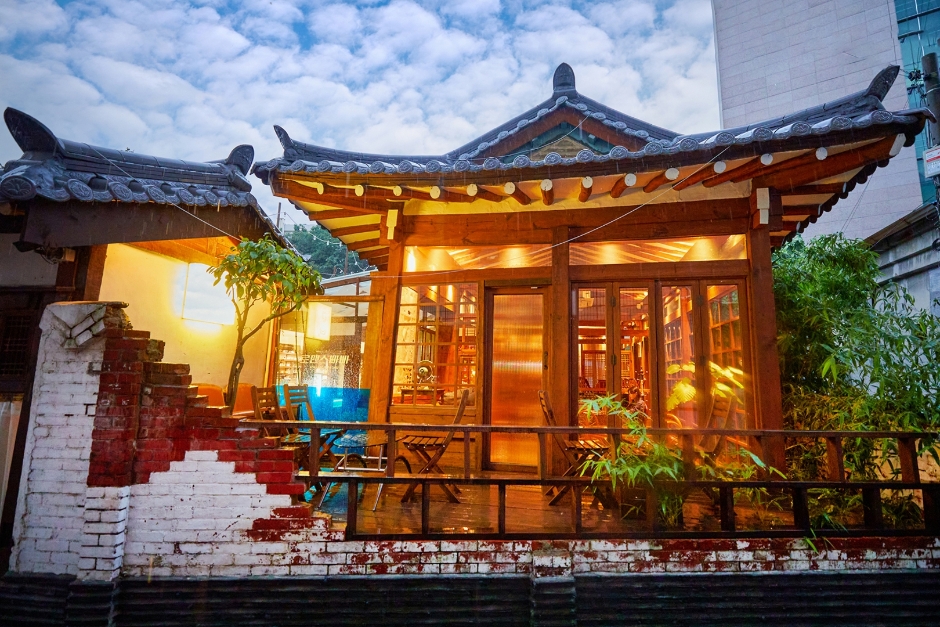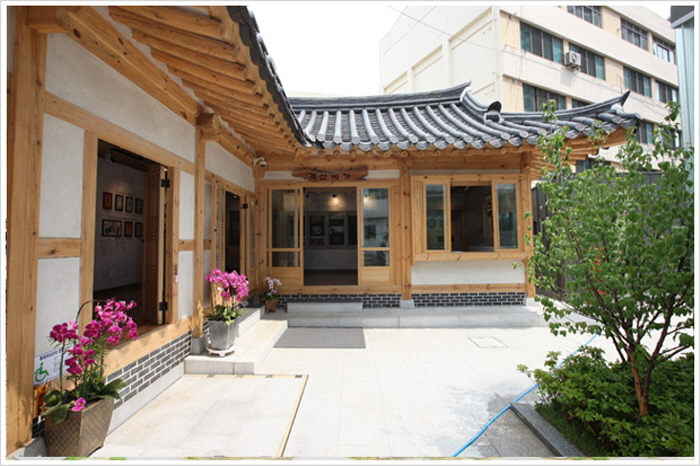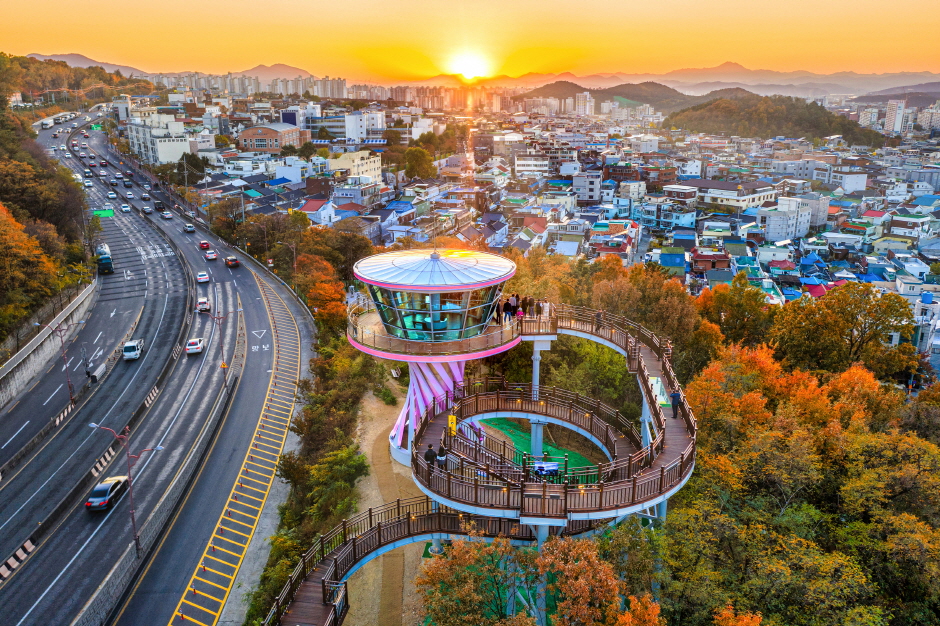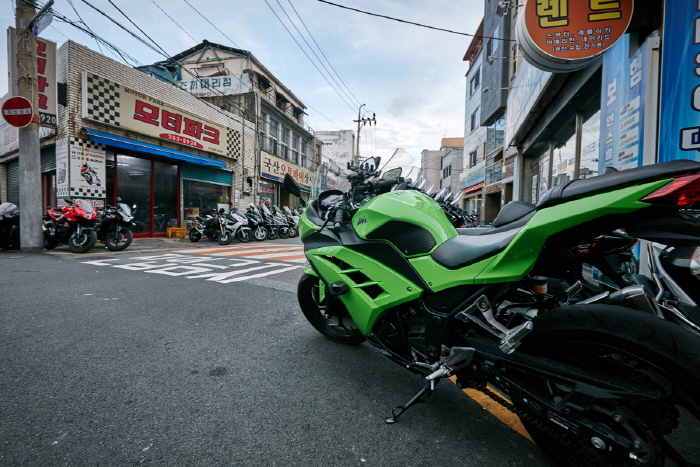March 1st Independence Movement Road (3·1만세운동길)
2.4Km 2023-01-20
Dongsan-dong, Jung-gu, Daegu
March 1st Independence Movement Road is a historical location where Daegu citizens gathered for the independence movement on March 8, 1919, and the midpoint of Daegu Modern Alley Tour Course 2. Passing Cheongna Hill Missionary's House and Jeil Church, you will come to a road with murals of the independence movement. The March 1st Independence Movement Road is a hilly road leading to Gyesan Cathedral. It is also called 90 Stairs because there are 90 steps. On the wall of the stairs, there is an augmented reality (AR) experience zone along with site photos from history. By scanning the QR code is a 3D video that vividly reproduces the independence movement, enabling a realistic experience of history. Follow the signs of the Daegu March 8th Independence Movement marching road to reach the main road and it will lead to the the 100th anniversary monument of the March 1st Movement and the starting point of the March 8 Movement. A guided alley tour is available for free with an online reservation on the official website.
Romance Papa (로맨스빠빠)
2.5Km 2024-04-01
492-6 Gukchaebosang-ro, Jung-gu, Daegu
This cafe is located near Seomun Market and Seomun Market Station on Daegu Subway Line 3. It is a hanok renovated with a retro and classic interior. Wooden doors and mother-of-pearl shelves between the seats create an atmosphere of warmth and relaxation, as if visiting a Korean grandmother's house. There are also seats in the yard where one can have coffee and dessert while enjoying the unique atmosphere of a hanok. The place has drinks and desserts made with various fruits and pour-over coffee. The signature menu here is called Perpetual Snow. It's similar to Einspänner, but it's topped with its own unique cream, so it's nutty and sweet. Visitors can also enjoy ade and smoothies with peach pulp in the summer.
House of Seo Sang-don (서상돈 고택)
2.5Km 2021-07-01
6-1, Seoseong-ro, Jung-gu, Daegu
+82-53-256-3762
The house of entrepreneur and activist Seo Sang-don is located in the heart of Daegu. In 1907, in an effort to repay national debt and to gain independence from Japan, Seo launched the National Debt Repayment Movement as well as a nationwide campaign calling for people to quit smoking.
In celebration of Seo's leadership, the City of Daegu restored Seo's old house and opened it to the public. The City also built the National Debt Repayment Park and erected a statue of Seo in his honor.
Modern History Experience Hall Gyesanyega (근대문화체험관 계산예가)
2.5Km 2021-04-27
6-1, Seoseong-ro, Jung-gu, Daegu
+82-53-661-3323
Modern History Experience Hall Gyesanyega opened in 2012 is a public space designed for rest and education. Visitors can enjoy a moment of relaxation while touring Daegu Modern Culture Alley, as well as learn more about the history of the area through the video hall and about the houses featured along the way, such as House of Yi Sang-hwa and House of Seo Sang-don, at the hanok exhibition hall.
Apsan Cafe Street (앞산카페거리)
2.5Km 2023-11-17
191 Daemyeongnam-ro, Nam-gu, Daegu
+82-53-627-1337
Apsan Cafe Street is filled with cafes of all different types. From houses modified into a cafe, restaurants, and gallery cafes, there are more than 40 coffee shops along the street. Most are cafes serving coffee, sandwichs, and desserts, but there are also restaurants serving pizza, pasta, and steak as well as Japanese food, pubs and pie shops. The street is perfect for couples going on a date or families looking for sweets. Attractions nearby include Apsan Park and Anjirang Gopchang Alley for a place to eat, drink and rest. Anjirang Station (Daegu Subway Line 1) is also 5-10 minutes away on foot.
House of Yi Sang-hwa (이상화 고택)
2.5Km 2023-01-06
6-1, Seoseong-ro, Jung-gu, Daegu
+82-53-256-3762
Yi Sang-hwa was a nationalist poet, who resisted the Japanese colonialism. This was his house from 1939 until his death in 1943. His house was neglected after he died, until a citizens' movement in 1999 to preserve the house urged the Military Mutual Aid Association to purchase it, and donate it to the City of Daegu on October 27, 2005. It has been restored and opened to the public, serving as the center for education of the poet's brave spirit and work.
Daegu Gyesan Cathedral (대구 계산동성당)
2.5Km 2024-07-31
10 Seoseong-ro, Jung-gu, Daegu
+82-53-254-2300
Daegu Gyesan Cathedral is one of Daegu's main churches, designed by Father Poisnel, who also designed Myeongdong Cathedral and imported stained glass for the windows directly from France. Being located in the city center, the cathedral is especially beautiful when seen at night.
Apsan Mountain Haeneomi Observatory (앞산 해넘이전망대)
2.5Km 2023-08-28
Daemyeong-dong, Nam-gu, Daegu
+82-53-664-2783
Apsan Mountain Haeneomi Observatory, where you can see the scenery of Daegu along with the sunset, is located in Apsan Ppallaeteo Park in Nam-gu. Incorporating the history and symbolism of Apsan Ppallaeteo Park, the observatory's design embodies laundry wring. The ramp leading to the observatory is perfect for walking as you can see the panoramic view of Apsan Mountain and the surrounding landscape.
Dowoo Health Care (주식회사 도우티앤비)
2.5Km 2025-07-29
(2nd Floor), 7 Bongdeok-ro 1-gil, Nam-gu, Daegu
With a branch in Hanoi, Vietnam, we have been engaged in the medical tourism business for Vietnamese patients since 2010, specializing in attracting patients from Hanoi, Danang, and Ho Chi Minh City. We also lead medical volunteer activities in Vietnam with Korean hospitals every year, and our local subsidiary in Vietnam is licensed to import Korean medical devices from Vietnam. We are evolving into a company that specializes not only in medical tourism but also in total healthcare. Since 2010, we have been leading cooperation between hospitals in Vietnam and Korea through hospital-to-hospital program exchanges, physician training, etc.
Daegu Motorcycle Street (대구 오토바이골목)
2.6Km 2021-02-09
Ingyo-dong, Jung-gu, Daegu
+82-53-627-1337
Daegu Motorcycle Street is located in Ingyo-dong, Jung-gu, Daegu along Sijangbuk-ro. The street was originally a creek lined with houses, but in 1953 the creek was covered over and made into a paved road. Gas stations and stores selling automotive parts sprung up, turning the area into a thriving commercial district. In 1961, the first motorcycle store opened its doors and was quickly followed by several more.
Currently there are 40 motorcycle stores, making this 200-meter-long street one of Daegu’s most unique shopping areas. Shoppers can find a vast array of new and secondhand motorcycles both domestic and imported, as well as a wide selection of motorcycle parts and accessories.






 English
English
 한국어
한국어 日本語
日本語 中文(简体)
中文(简体) Deutsch
Deutsch Français
Français Español
Español Русский
Русский